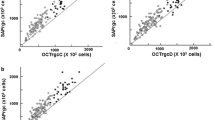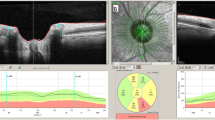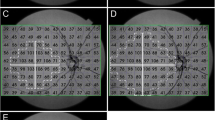Abstract
Background
We differentiated between normal and glaucomatous eyes in the Taiwan Chinese population based solely on the quantitative assessment of summary data reports from Stratus optical coherence tomography (OCT) by comparing their area under the receiver operating characteristic (ROC) curve.
Methods
One randomly selected eye from each of the 62 patients with early glaucomatous damage (mean deviation −2.8 ± 1.8 dB) and from each of the 62 age- and sex-matched normal individuals were included in the study. Measurements of glaucoma variables (retinal nerve fiber layer thickness and optic nerve head analysis results) were obtained by Stratus OCT. Twenty-one OCT parameters were included in a linear discriminant analysis (LDA) using forward selection and backward elimination to determine the best combination of parameters for discriminating between glaucomatous and healthy eyes based on ROC curve area.
Results
The average RNFL thickness was the best individual parameter for differentiating between normal eyes and glaucomatous eyes (ROC curve area 0.793). The maximum area under the ROC curve of six input parameters (average RNFL thickness; 10, 11, and 12 o’clock segment thicknesses; cup area; and vertical integrated rim area) generated by the forward selection method was 0.881. Whereas the maximum area under the ROC curve of 15 input parameters (average RNFL thickness; 1, 3, 4, 6, 8–10, 12 o’clock segment thicknesses; vertical integrated rim area; horizontal integrated rim area; disc area; cup to disc area ratio; cup to disc horizontal ratio; and cup to disc vertical ratio) generated by backward elimination method was 0.929.
Conclusions
The performance of individual parameters obtained from Stratus OCT is fairly reliable for differentiating the early glaucomatous eyes from normal eyes. However, the discriminant power increases when LDA with forward selection and backward elimination methods is applied.



Similar content being viewed by others
References
Bowd C, Weinreb RN, Willams JM et al (2000) The retina nerve fiber layer thickness in ocular hypertensive, normal, and glaucomatous eyes with optical coherence tomography. Arch Ophthalmol 118:22–26
Bowd C, Zangwill LM, Berry CC et al (2001) Detecting early glaucoma by assessing of retina nerve fiber layer thickness and visual function. Invest Ophthalmol Vis Sci 42:1993–2003
Bowd C, Chan K, Zangwill LM et al (2002) Comparing neural networks and linear discriminant functions for glaucoma detection using confocal scanning laser ophthalmoscopy of the optic disc. Invest Ophthalmol Vis Sci 43:3444–3454
Caprioli J, Park HJ, Ugurlu S et al (1998) Slope of the peripapillary nerve fiber layer surface in glaucoma. Invest Ophthalmol Vis Sci 39:2321–2328
Colen TP, Tang NE, Mulder PG et al (2004) Sensitivity and specificity of new GDx parameters. J Glaucoma 13:28–33
El Beltagi TA, Bowd C, Boden C et al (2003) Retinal nerve fiber layer thickness measured with optical coherence tomography is related to visual function in glaucomatous eyes. Ophthalmology 110:2185–2191
Essock EA, Sinai MJ, Bowd C et al (2003) Fourier analysis of optical coherence tomography and scanning laser polarimetry retinal nerve fiber layer measurements in the diagnosis of glaucoma. Arch Ophthalmol 121:1238–1245
Ford BA, Artes PH, McCormick TA et al (2003) Comparison of data analysis tools for detection of glaucoma with the Heidelberg retina tomograph. Ophthalmology 110:1145–1150
Funaki S, Shirakashi M, Yaoeda K et al (2002) Specificity and sensitivity of glaucoma detection in the Japanese population using scanning laser polarimetry. Br J Ophthalmol 86:70–74
Greaney MJ, Hoffman DC, Garway-Heath DF et al (2002) Comparison of optic nerve imaging methods to distinguish normal eyes from those with glaucoma. Invest Ophthalmol Vis Sci 43:140–145
Guedes V, Schuman JS, Herzmark E et al (2003) Optical coherence tomography measurement of macular and nerve fiber layer thickness in normal and glaucomatous human eyes. Ophthalmology 110:177–189
Gurses-Ozden R, Teng C, Vessani R et al (2004) Macular and retinal nerve fiber layer thickness measurement reproducibility using optical coherence tomography (OCT-3). J Glaucoma 13:238–244
Hee MR, Izatt JA, Swanson EA et al (1995) Optical coherence tomography of the human retina. Arch Ophthalmol 113:325–332
Hoh ST, Ishikawa H, Greenfield DS et al (1998) Peripapillary nerve fiber layer thickness measurement reproducibility using scanning laser polarimetry. J Glaucoma 7(1):12–15
Hoh ST, Greenfield DS, Mistlberger A et al (2000) Optical coherence tomography and scanning laser polarimetry in normal, ocular hypertensive, and glaucomatous eyes. Am J Ophthalmol 129:129–133
Horn FK, Jonas JB, Martus P et al (1999) Polarimetric measurement of retinal nerve fiber layer thickness in glaucoma diagnosis. J Glaucoma 8:353–362
Iester M, Mikelberg FS, Swindale NV et al (1997) ROC analysis of Heidelberg retina tomograph optic disc shape measures in glaucoma. Can J Ophthalmol 32:382–388
Jaeschke R, Guyatt G, Lijmer J (2002) Diagnostic tests. In: Rennie D (ed) Users’ guides to the medical literature: essentials of evidence-based clinical practice. AMA, Chicago, pp 187–217
Jaffe GJ, Caprioli J (2004) Optical coherence tomography to detect and manage retinal disease and glaucoma. Am J Ophthalmol 137:156–169
Kanamori A, Nakamura M, Escano MFT et al (2003) Evaluation of the glaucomatous damage on retinal nerve fiber layer thickness measured by optical coherence tomography. Am J Ophthalmol 135:513–520
Kiriyama N, Ando A, Fukui C et al (2003) A comparison of optic disc topographic parameters in patients with primary open angle glaucoma, normal tension glaucoma, and ocular hypertension. Graefes Arch Clin Exp Ophthalmol 241:541–545
Kleinbaum DG, Kupper LL, Muller KE (1998) Applied regression analysis and other multivariate methods, 2nd edn. PSW-Kent, Boston
Medeiros FA, Zangwill LM, Bowd C et al (2004) Comparison of the GDx VCC scanning laser polarimeter, HRT II confocal scanning laser ophthalmoscope, and Stratus OCT optical coherence tomography for the detection of glaucoma. Arch Ophthalmol 122:827–837
Mistlberger A, Liebmann JM, Greenfield DS et al (1999) Heidelberg retina tomography and optical coherence tomography in normal, ocular-hypertensive, and glaucomatous eyes. Ophthalmology 106:2027–2032
Munkwitz S, Funk J, Loeffler KU et al (2004) Sensitivity and specificity of scanning laser polarimetry using the GDx. Br J Ophthalmol 88:1142–1145
Nouri-Mahdavi K, Hoffman D, Tannenbaum DP et al (2004) Identifying early glaucoma with optical coherence tomography. Am J Ophthalmol 137:228–235
Paunescu LA, Schuman JS, Price LL et al (2004) Reproducibility of nerve fiber thickness, macular thickness, and optic nerve head measurements using Stratus OCT. Invest Ophthalmol Vis Sci 45:1716–1724
Pieroth L, Schuman JS, Hertzmark E et al (1999) Evaluation of focal defects of the nerve fiber layer using optical coherence tomography. Ophthalmology 106:570–579
Reus NJ, Lemij HG (2004) Diagnostic accuracy of the GDx VCC for glaucoma. Ophthalmology 111:1860–1865
Ripley BD (1996) Pattern recognition and neural networks. Cambridge University Press, Cambridge
Sanchez-Galeana C, Bowd C, Blumenthal EZ et al (2001) Using optical imaging summary data to detect glaucoma. Ophthalmology 108:1812–1818
Sanchez-Galeana CA, Bowd C, Zangwill LM et al (2004) Short-wavelength automated perimetry results are correlated with optical coherence tomography retinal nerve fiber layer thickness measurements in glaucomatous eyes. Ophthalmology 111:1866–1872
Schoonjans F (2003) MedCalc for windows. Medcalc Software, Belgium
Schuman JS (2004) Optical coherence tomography of ocular disease. In: Schuman JS, Puliafito CA, Fujimoto JG (eds) Optical coherence tomography of ocular diseases, 2nd edn. Slack, Thorofare, NJ
Schuman JS, Hee MR, Arya AV et al (1995) Optical coherence tomography: a new tool for glaucoma diagnosis. Curr Opin Ophthalmol 6:89–95
Schuman JS, Hee MR, Puliafito CA et al (1995) Quantification of nerve fiber layer thickness in normal and glaucomatous eyes using optical coherence tomography. Arch Ophthalmol 113:586–596
Schuman JS, Wollstein G, Farra T et al (2003) Comparison of optic nerve head measurements obtained by optical coherence tomography and confocal scanning laser ophthalmoscopy. Am J Ophthalmol 135:504–512
Teesalu P, Tuulonen A, Airaksinen PJ (2000) Optical coherence tomography and localized defects of the retinal nerve fiber layer. Acta Ophthalmol Scand 78:49–52
Thompson ML, Zucchini W (1989) On the statistical analysis of ROC curves. Stat Med 8:1277–1290
Wallstein G, Schuman JS, Price LL et al (2004) Optical coherence tomography (OCT) macular and peripapillary retinal nerve fiber layer measurements and automated visual fields. Am J Ophthalmol 138:218–225
Weinreb RN, Zangwill L, Berry CC et al (1998) Detection of glaucoma with scanning laser polarimetry. Arch Ophthalmol 116:1583–1589
Williams ZY, Schuman JS, Gamell L et al (2002) Optical coherence tomography measurement of nerve fiber layer thickness and the likelihood of a visual field defect. Am J Ophthalmol 134:538–546
Zafar S, Gürses-Özden R, Makornwattana M, Vessani R, Liebmann JM, Tello C, Ritch R (2004) Scanning protocol choice affects optical coherence tomography (OCT-3) measurements. J Glaucoma 13:142–144
Zangwill LM, Bowd C, Berry CC et al (2001) Discriminating between normal and glaucomatous eyes using the Heidelberg retina tomography, GDx nerve fiber analyzer, and optical coherence tomography. Arch Ophthalmol 119:985–993
Zangwill LM, Chan K, Bowd C et al (2004) Heidelberg retina tomograph measurements of the optic disc and parapapillary retina for detecting glaucoma analyzed by machine learning classifiers. Invest Ophthalmol Vis Sci. 45:3144–3151
Acknowledgements
The authors would like to thank the National Science Council of the Republic of China for financially supporting this research under contract no. NSC-93-2218-E-167-001.
Author information
Authors and Affiliations
Corresponding author
Rights and permissions
About this article
Cite this article
Chen, HY., Huang, ML. Discrimination between normal and glaucomatous eyes using Stratus optical coherence tomography in Taiwan Chinese subjects. Graefe's Arch Clin Exp Ophthalmol 243, 894–902 (2005). https://doi.org/10.1007/s00417-005-1140-y
Received:
Revised:
Accepted:
Published:
Issue Date:
DOI: https://doi.org/10.1007/s00417-005-1140-y




